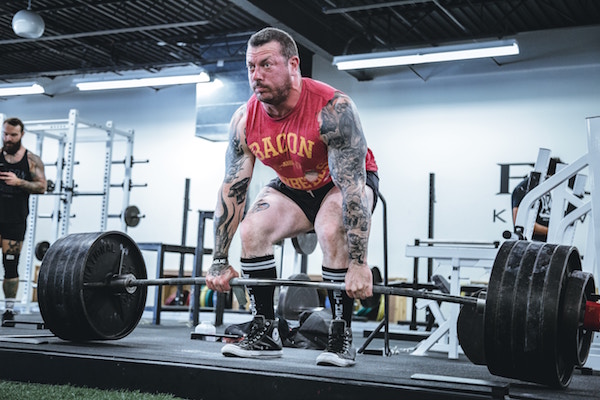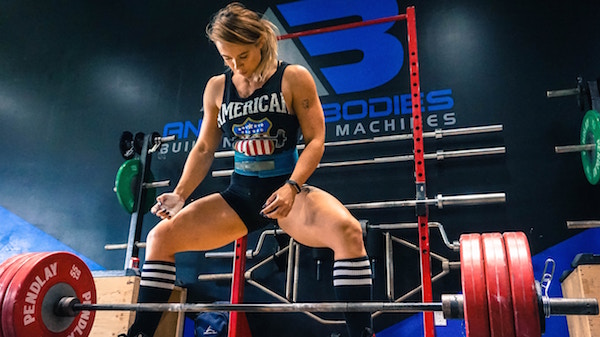The deadlift is an awesome exercise.
It may not be quite the mass builder that squats are, but the deadlift is an excellent measure of your overall strength and power.
It will probably be your heaviest and strongest lift, and it takes an enormous amount of muscle and power to move heavy weights from a dead stop off the floor.
That’s why so many people are enamored with building a big deadlift.
But how long will it take to deadlift 405 pounds (four plates) and beyond? Is a 405 deadlift good?

It will probably take you at least a year of serious training to achieve a four plate deadlift, and probably longer than that — two, three, or more years is common. Is a 405 deadlift good? Absolutely! You won’t win any powerlifting competitions with those numbers, but you’ll be stronger than 99% of recreational lifters in commercial gyms.
Of course, how fast you build your deadlift depends on a ton of different factors:
- Your bodyweight
- Whether you’re bulking or cutting
- Previous training history
- Genetics
- Programming/routine
- Gender
- And more
So let’s take a little bit of a closer look at the journey to a 405 deadlift and beyond, and what you might expect along the way.
Your Bodyweight
Most of us know by now that lifting heavy weights get easier as you get heavier.
The more you weigh, the more you can usually lift!
There are a few reasons (and possible reasons) for this:
- Better leverage and a stronger base
- More overall muscle mass
- More tissue around joints provides better stability
Whatever the exact mechanics of this phenomenon are, exactly, we aren’t precisely sure. But we do know that when bodyweight goes up, it usually means your max strength goes up, too.
This is why most lifts are better measured in terms of bodyweight multiples, rather than raw pounds.
A 405 deadlift, for example, would be a more-than 3x bodyweight lift for a 130-pound man and would qualify as an elite-level lift according to StrengthLevel.com.
However, for a 300-pound man, a 405 deadlift is less than 1.5x bodyweight and would be considered only a novice-level lift.
So to figure out how long it’ll take to achieve a four plate deadlift, first figure out what percentage of your bodyweight that lift would be. The greater the multiple, the longer it’ll take you to reach it.
Bulking vs Cutting
You’re going to need some meat on your bones to deadlift 405 and beyond.
Sure, you’ll have your “newbie gains” phase when you first start lifting. During that period, you’ll be able to easily add 5-10 pounds to your deadlift every week whether you’re eating right or not.
But those easy gains will run out far before you ever hit 405.
At that point, you’ll have to decide if you want to enter a proper bulk (eating in a calorie surplus) to gain more muscle and strength.
Or if you want to cut and strip away some fat for a lean, chiseled look.
The more time you spend in a bulking phase, adding overall mass and muscle, the faster you’ll reach your deadlift goal (or any strength goal).
You’ll also add more fat that way.
The best way to do it is to keep your daily calorie surplus small (250-500 calories) and eat (mostly) clean, whole foods.
That’s the idea behind a lean bulk, and it’ll help you put on muscle and build your deadlift while minimizing fat gain.
Though it will take longer than “dirty bulking,” or eating whatever the hell you want, fat be damned!
Previous Training History
If you used to be able to deadlift 405 (back in high school, or before an injury derailed your training, for example), you’ll probably be able to rebuild that strength a lot quicker than someone training from scratch.
Muscle memory means our bodies are primed to recover lost muscle mass quickly.
They also remember movement patterns well and easily relearn how to engage and recruit the muscle needed to lift heavy weights.
A complete newbie learning how to deadlift for the first time will have a much harder time reaching lofty numbers than someone who used to be quite strong but hasn’t trained in a while.
(Remember this when someone tells you they deadlifted 405 in just a few months. Chances are they used to be crazy strong and simply needed to retrain their bodies to the same level.)
Genetics
Simply put? Some people are just lucky.
Now who knows if “hardgainers” and “easygainers” are really a thing, but I do know that no two people will respond to training the exact same way.
If you took two people of:
- The same gender
- The same age
- The same weight
- The same training history
And put them on the same program, they might have similar results, but they wouldn’t have the exact same results.
There’s just no way.
One guy might reach a 405 deadlift in a year and a half, the other might take two years.
There are too many factors that go into strength progress. Testosterone levels, intensity and effort, diet adherence, sleep, stress levels, and more.
And even if you could somehow control for all of that, some people just seem more apt to gain strength and muscle quickly while others struggle.
There’s no use comparing yourself to the next guy. You can only compete against yourself and what you did in the gym yesterday or last week, and that’s the way it should be.
Programming / Routine
If you’re training specifically to build a huge deadlift, you’ll probably have faster results than someone who’s doing a more well-rounded strength program.
A lot of popular programs put a bigger emphasis on squats, for example. Others focus much more on upper body work on the chest, shoulders, back, and arms.
If a four plate deadlift is really important to you, you might want to consider a deadlift-specific program that will give you faster gains than an all-around program that happens to include deadlifts.
There are lots of options for this, including:
- Deadlifting heavy once per week
- Deadlifting multiple times per week with volume
- Deadlifts and variations every day
And so on.
The deadlift is, however, one of the most taxing exercises you can possibly put your body through, so it’s important to manage your volume and recovery well.
There are a ton of different approaches that can work well for this, and your mileage may vary with each of them.
Feel free to experiment with different deadlifting programs until you find the one that brings you the best results.
(You may find that the approach that helped you build a 315 deadlift isn’t the same one that will take you to 405 and beyond.)
Gender (Can women deadlift 405 pounds?)

Strength standards for men are higher than they are for women of the same bodyweight.
There are tons of genetic and biological reasons for this, but in any case, it’s important to consider gender and sex when determining strength levels.
Can women realistically expect to reach a 405 deadlift?
It’s definitely possible but would be a HIGHLY elite-level lift, even for women over 200 pounds.
According to the Washington Post, the average American woman weighs about 160 pounds. For a woman of that size, a three-plate deadlift would be considered elite.
A four-plate deadlift would definitely be competition worthy!
It’s definitely possible for women to deadlift 405, and there are many that can, but it’s ambitious goal that will require many years of intense training and dedication.
Is a 405 deadlift impressive?
Abso-friggin’-lutely it is.
A 405-pound deadlift is extremely impressive for normal recreational lifters.
A lot of keyboard warriors online make it sound really easy to train for a year and hit a two-plate bench, three-plate squat, and four-plate deadlift, just like that.
It most definitely is not.
Walk into any commercial gym and you’ll very, very rarely see anyone hitting those numbers consistently except for the strongest guys in the gym. If you’re wondering how many people can deadlift 405, just see how many you can count. It won’t be very many!
Specialized powerlifting gyms would be the exception, but those aren’t your average gym-goers.
A four-plate deadlift is a beyond-elite lift for basically any woman.
For men under 220 pounds or so, a four-plate deadlift is an advanced to elite lift.
Hitting that number will take quite a bit of time, intense training, and dedicated adherence to your nutrition.
You may have loftier goals, in the end, but you should definitely be proud of that achievement if you’re able to get there.
How long will it take to deadlift 495 or 500 pounds?
To road from 405 to 500 will be a long and grueling one, most likely.
A 500-pound deadlift would be an elite lift for almost anyone, so don’t expect to hit those kinds of numbers without a few years of serious training and deadlift specialization.
You’ll need to add some serious muscle to your frame over the course of several years and meticulously program your deadlift.
(All-around strength programs probably won’t get you to a 500 deadlift quickly, if at all.)
The truth is 99% of amateur lifters will never hit this number. That’s why it’s considered elite!
But it’s a worthy goal to chase, and absolutely in-reach if you dedicate yourself to it for a few years and focus on making incremental progress over time.
Wrapping Up
Your deadlift can get stronger VERY quickly when you first start lifting.
In fact, don’t be surprised if you can add 10 or more pounds to the bar every workout in the very beginning.
But somewhere around two or three plates, you’ll find that progress slows down significantly and you’ll need to train smarter and harder to reach a 405 deadlift.
To get really strong on the deadlift, there’s a good chance you’ll need to program it specifically (or just be really patient on your current program).
(Here’s a good, simple deadlift program to get you started from T Nation)
Expect it to take at least a year, but probably a good bit longer for most people to reach a four-plate dead.
If and when you get there, don’t let the Internet trolls bring you down. It’s a huge achievement you should be proud of!
For more, check out timelines and tips for:
Hope this helps.